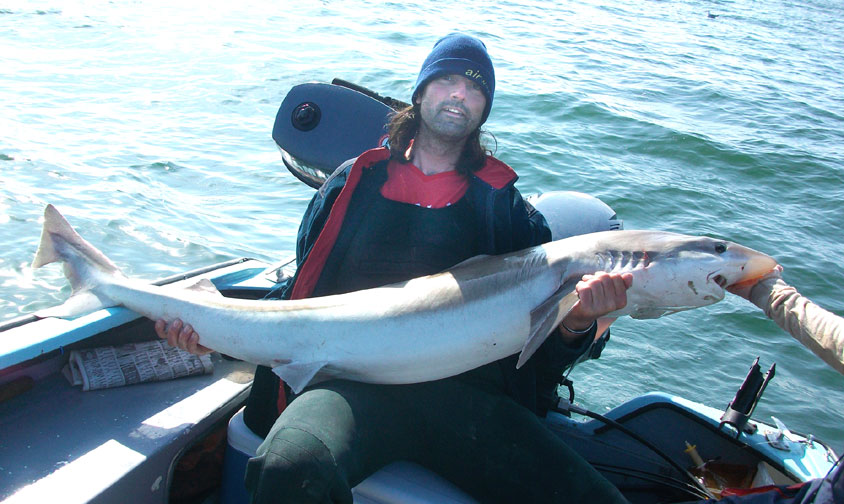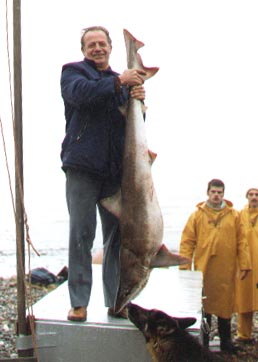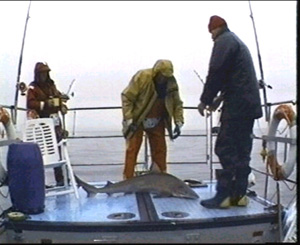Tope 2000 Up-date 3 (Galeorhinus galeus)
by Len Nevell
(unedited)
British Tope* are the largest, of the more common shark species found
around the British coast growing to over 2 metres T/L. Feeding mainly on
fish and sometime crustaceans.
(*Porbeagles, Thresher, Basking, Blue Sharks
are all larger and found inshore.)
This year has been very good for Tope with 23 large specimens of over
30 lb (13.6 kg) reported especially between August and early October
with catches of many sharks between 40 lb (18.1 kg) and 65 lb
(29.5
kg) and up to nearly 2 metres T/L with catches from :-
Catches from north Devon rocky marks:
Tope of 48 lb 4 oz (21.9 kg) and 40 lb (18.1 kg)
caught from Nr. Devon shore mark by Gary Andrews.
Tope of 44 lb 9 oz (20.4 kg) caught and released from
Nr. Devon shore-mark at Clovelly during a night session by Jason Barrows,
from Barnstable
Their is a very large resident Tope population, some move close in shore
to feed and are caught from the beach or rocks, the largest this year was
51 lb 4 oz (23.2 kg).
This huge shark was caught by Jason Barrows who has caught a number
of large specimens from this area at Clovelly, north Devon a few miles
from Baggy Point where the British record specimen of 58 lb 2 oz
(26.4
kg) was caught in 1982.
Tope of 23 lb (11.3 kg) caught from Anglesey shore mark, returned
alive.
Tope of 43 lb (19.5 kg) and 2 of 35 lb (15.9 kg) caught
off Abersoch, West Wales by John Evans from Shrewsbury on board Oni Lloyd
Jones boat 'Jenny II'.
Sheltered Shannon waters off Ireland between counties Clare and Kerry
has great potential for anglers. With a wide range of species from Tope
to 50 lb (22.7 kg).
South-west Scotland has produced great Tope of 32 lb 11
oz
(14.9
kg) and another of 29 lb 9 oz (13.4 kg) from Luce Bay caught
by John Stevenson of Newton Stewart, Scotland.
Tope to 35 lb (15.9 kg) from Boston Deep off Lincolnshire.
Tope of 42 lb (19 kg), 39 lb (17.7 kg) and 29 lb (13.8
kg) caught from around Candy Is. off South Wales.
14
June 2009

How much does
this Tope weigh?
I recently
caught a large Tope, Galeorhinus
galeus, from my own boat while fishing in
Wigtown
Bay, south west Scotland.She pulled my 55 lb salter scales dead
when I tried to weigh her in the sling, her measurements were 175 cm (69
inches) in length and just over 82 cm (32 inches) in girth. I've been looking
at quite a few pictures of Tope
caught and think that she looks a rather substantial weight, although the
pictures do not do her justice.
Simple
relationship from several thousand tope records from the UK Shark
Tagging Programme (look at my web site) length and weight suggests 69ins
= 47 lb
But
fat females are heavier so I have this worked out this formula which allows
for girth
The
overall relationship (ins & lbs)
log(Wt)
= 0.8076 * log(Length) + 1.7249*log(Girth) - 2.1716
LOG10
weight = 0.8076 * LOG(69) + 1.7249*LOG(32) - 2.1716
weight
= 82 lb
isn't
science wonderful !
Best
wishes
Ken
Dr
Ken Collins
Senior
Research Fellow
School
of Ocean and Earth Science, University of Southampton
National
Oceanography Centre, Southampton SO14 3ZH, UK
Scientific
Diving Supervisory Committee www.uk-sdsc.com
UK
Shark Tagging Programme www.ukshark.co.uk
Large
Tope from Sussex 1997
 Photograph:
Photograph:
Tope
caught a half mile off Goring, West Sussex by Mr. Flowers in January 1982.
Weight reported of 53 kg (118 lb) thought to be too heavy for the
length (AH). Caught in gill nets.
Weight
has not been checked when compared to the estimated length of 175 cm. I
would say the weight was more likely to be 36 kg (80 lb). This is
a large specimen.
Tope off Hillston, East Yorkshire :-
Tope of 59 lb (26.8 kg), 58 lb (26.3 kg), 52 lb (23.6
kg), 46 lb (20.9 kg) for Neville Charlesworth, plus tope of 61 lb
(27.7
kg) and 48 lb (21.8 kg) for his Dad, plus 4 tope for 204
lb (92.7
kg), the biggest weighing 65 lb (29.5 kg) for Dale Hewitt.
Neville Charlesworth an Angling Times columnist during a small boat
session off Hillston aboard his fathers cobble.
The largest reported was estimated at nearly 85 lb (38.6 kg)
which must of been over 2 metres T/L which is one of the largest ever reported.Caught
off Anglesey north Wales:-
Tope estimated at 85 lb (38.6 kg) was caught and lost off Anglesey
by Yorkshire angler John Bailey. Aboard charter boat 'Stingray' skippered
by Dave Williams who had estimated a previous Tope of 48 lb (21
kg) at 50
lb (22.7 kg). When the huge tope was brought alone side
he had a good look at it and estimated it at 85 lb (38.6 kg) which
is 3 lb more than the UK record specimen.
Lack of the right equipment he was unable to bring the shark aboard
and it had to be released.
A similar size specimen was reported from the Isle of Mull, Scotland
this time last year and another 30 specimens of over 30 lb (13.6
kg) were caught during the summer and autumn 1999.
It is a very important sighting and report to show there is still some
very large specimens and large numbers of this species still around the
UK. It also shows how well a species can survive while not being a major
food or fin-soup source at the moment.

22
September 1999
A
large Tope, Galeorhinus galeus,weighing
between 38 and 40 kg (85 to 90 lb), was tagged and released off
the Isles of Mull, Scotland, not knowing that it was a new record weight
for the species.
This
weight may be overestimated. A figure of 25 kg (55 lb) seems about
right.
(Len
Nevell, Sea Angling Report)
Hello David & Jeri and others,
TOPE
Galeorhinus galeus
Thanks for the helpful replies. I have looked at your web page under
Tope.
Uk Sea Anglers Sharks. http://www.ukshark.co.uk
The original message was not sent with a great deal of studious care.
Largest on Record?
I just wanted to know the largest Galeorhinus galeus on record,
and although I could have looked it up, one might have been caught last
week, and if anybody would know ...
As an after thought I thought it a bit mercenary asking questions without
contributing anything in return so I uploaded some information Len Nevell
sent me.
I will amend my records in the light of the new information.
More Queries/Semantics
Your answer (from Sue & Jeri) has thrown up more queries, some semantic.
I wrote "not very common" in the English Channel. What I should have wrote
was "not very common" in the northern English Channel. This is what Lists
are all about. It was a discussion/opinion open to criticism. It was bad
writing anyrate. This is not the only point arising though.
Prevalency: is there any agreed word usage on prevalency,
e.g. ACFOR
Abundant, Common, Frequent, Occasional, Rare.
for sharks.
Other Query
Have we got a length comparison to weight for Galeorhinus galeus
for gravid females?
I expect there is and I will try to look it up.
Photograph
This was included by coincidence. I was looking through some old papers
and I came across the photograph after I posted the original message.
As this was a record I received, I was a bit dubious about the published
weight (after I sent the message). My estimate of the length of the gravid
female is 175 cm. What would be the weight of this shark?
Note: the fishermen who caught it in January 1982 did not identify it
as a Tope! (He thought it was a Blue Shark, Finished laughing? But it does
indicate he was not in the "I have found a large Tope!" brigade. The weight
needs to be checked.) The identification has been checked from the poor
photograph.
http://www.smartgroups.com/pictures/openpicture.cfm?GID=3D225938&AlbumID=3D=316345&PictureID=
3D130730&Layout=3DL&Sort=3DDateUploaded&Dir=3DDESC
Best to cut and paste this location.
tope4.htm
(This page contains notes, and the records have not been verified,
or checked by me in any way)
NB: Of Sussex, most commercial catches of Porbeagles and larger Tope
in the last decade occur in winter (January & February) but in the
inshore waters they are only occasional ("not very common"). This may reflect
the greater fishing activity during these months.
Anyrate, to confirm I asked an experienced fishermen about Porbeagles
and he said that they are only occasionally caught, and that many of them
turn out to be large Tope and the records of Tope off Sussex seem to be
somewhere between occasional and frequent, but getting less. These are
winter catches in gill nets.
Migratory
Do the tagging records confirm the southerly migrations in winter?
I am not doubting it - it rings true.
What are the normal temperature amplitudes for Galeorhinus galeus?
Their occurrence off the Sussex coast fluctuates from year to year,
maybe in connection with the availability of prey?
The original message has not been repeated to save space.
Cheers
Andy Horton
British Marine Life Study Society
EMail:Glaucus@hotmail.com
(EMail messages are not monitored by third parties.)
Marine Wildlife of the North-east Atlantic Ocean Group (commenced 1
August 2000)
Group Home: http://uk.groups.yahoo.com/group/Glaucus
Hello,
You are assuming the reference sources. They are a combination of the
Fisheries Office (ex-fishermen) the fishing merchants, numerous fishermen.
I lived in the boatyard and anything special that came up, I would usually
hear about it, but this was only from 1974 to 1984.
The biggest fishing ports in Sussex are Hastings, Newhaven, Shoreham
and Littlehampton and perhaps Bognor.
26 fishing boats (13 full time) work from Shoreham catching whitefish
and shellfish. Probably less now, this was a couple of years ago.
The Porbeagles are not common because some of the fishermen (even after
30 years in the trade) cannot identify them (apparently). However, other
small Porbeagles have been caught recently.
The Bass trawlers operate out of Newhaven and nobody really likes them
much. I have no records of their incidental catches.
The Tope in the photograph I estimate at about 175 cm long so the weight
was exaggerated (doubled?). 60lb or 27 kg would be more realistic?
The Cod fishery occurs (until it gets stopped) in winter and most records
of large Tope are associated with this.
The best way to get the picture only is:
tope4.jpg
The reason why the first picture could not be accessed is because of
an anomaly in how the Shark-L stores the information. Long URLs do not
work when the message is sent by EMail. (I have only just discovered this.)
This happens with other (but not all) lists as well.
Anecdotes
Fishermen are laying gill nets in summer but I have no records of Tope
from them for 2000 out of Shoreham. However, they would only mention the
larger ones. Say 200 boats go out out each year from Sussex. I can only
guess the numbers of Tope caught but some fishermen cannot remember the
last time they caught one, and some never have. Say once every 5 years,
which perhaps give a number of about 40 a year. Would this be regarded
as common? frequent or occasional? I think it is probably less than this.
Most reports (the ones I receive) are in the winter, but this is only because
of the fishery methods. To say they fluctuate is meaningless because the
numbers are too small.
Monkfish, Squatina squatina, come right inshore, one maximum
in the nets, and I have caught these in beach seines for Grey Mullet when
these were legal. They were not eaten then.
Cheers
Andy Horton
British Marine Life Study Society
EMail:Glaucus@hotmail.com
(EMail messages are not monitored by third parties.)
Marine Wildlife of the North-east Atlantic Ocean Group (commenced 1
August 2000)
Group Home: http://uk.groups.yahoo.com/group/Glaucus
In message <000e01c05d4b$f72fa8c0$2f498018@ne.mediaone.net>,
Capt. Tom
<capt.tom@MEDIAONE.NET> writes
Hi All
>
>Since there are no dimensions given and I have only the picture to
go by I would say the shark is 5- 51/2 feet to the fork depending on how
tall that gentleman is. The shark is not as chubby as a porbeagle or as
slim as a blue shark. Based on that, my Guess is the shark in the
picture weighs about 100 lbs.US.- Tom
To try and set some light on this fish:
Assuming that the total length might be 66", with a reasonable range
of girth measurements of 28" - 32", the fish would weigh between 66-80lbs!
Regards
Sue & Jeri Drake
Home Page: Uk Sea Anglers Sharks. http://www.ukshark.co.uk/
September
2005

Stuart
Johnson (in the picture), and he caught a
female Tope, Galeorhinus galeus, on
rod and line (it took 15 minutes to land)
eight miles off Brighton Marina, Sussex, in about 30 metres of water. It
was weighed at 25 lb (about 11 kg) and the shark was tagged and
returned to the sea alive and unharmed. Tope
are unusual captures off the Sussex coast.
BMLSS
Sharks
Shark Page
Tope Page


